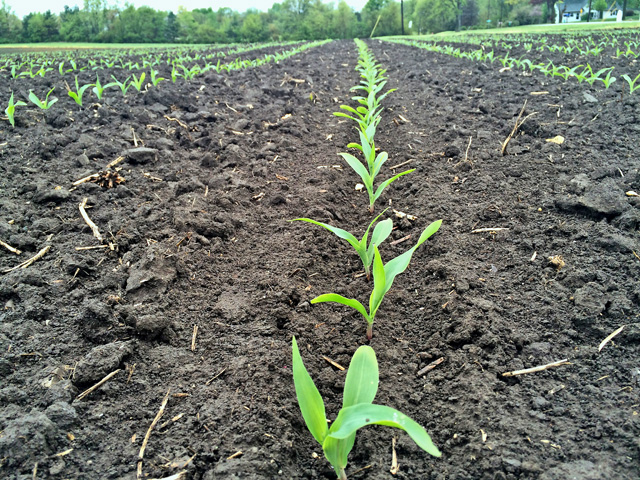Minnesota Corn Farmers Shift to Urea
Wet Weather Influences Shift in Nitrogen Use and Storage
OMAHA (DTN) -- Corn producers in Minnesota are shifting their nitrogen source of choice toward urea and away from anhydrous. This change has created some discussion about urea management practices, especially if applied in the fall.
The University of Minnesota Extension Nutrient Management recently held a podcast titled "Nitrogen Economics" that stressed that regardless of what form of nitrogen is the most popular, timely applications during wet weather remains a problem.
MOVING TOWARDS UREA
University of Minnesota Extension Educator Brad Carlson, located in Mankato, Minnesota, said the trend toward using urea has been in place for several years now.
Minnesota farmers once depended on anhydrous, the most economic nitrogen source, but have moved away from use due to safety issues, he said. Urea's popularity has steadily grown during the last 20 years.
Jane Boerboom, supervisor of the facility management unit at the Minnesota Department of Agriculture (MDA), said the state's fertilizer storage data in recent years also shows the trend is towards using more urea.
In 1997, 437 of facilities in Minnesota were permitted to store anhydrous ammonia. As of 2020, that number fell to 237 facilities, she said.
"So there have been a lot of facilities that have either gone out of the anhydrous ammonia business or have merged by other facilities and have created efficiencies in those delivery and sales systems for anhydrous ammonia," Boerboom said.
She said MDA fertilizer sales information also shows more farmers in the state are using urea as their nitrogen source.
In 1989, 150,000 tons of urea were sold in the state. Thirty years later, that number was 350,000 tons of urea, she noted.
P[L1] D[0x0] M[300x250] OOP[F] ADUNIT[] T[]
MORE ON-FARM FERTILIZER STORAGE
Another trend in Minnesota during the last five years is more farmers are building fertilizer storage facilities on their own farms. Out of the 237 facilities permitted to store anhydrous, 18 were farmer storage facilities, she said.
Those farmers who want to store dry fertilizer on farm have been on the rise, she said. A permit is required to store dry fertilizer and out of the 665 permits in the state to store dry fertilizer, 140 permits or 21% of these are farm storage permits.
As for storing liquid fertilizer, there is an exemption for farmers, Boerboom said. A farmer can store 6,000 gallons or less of liquid fertilizer without a permit through the Minnesota Department of Agriculture, she said.
If farmers want to store more than this amount, they will need to work with the state government agency and install environmental safeguards to prevent contamination, she said.
"The last year was a really hard time for farmers to get their nutrients on the field in the fall due to those wet conditions," she said. "I think those types of weather situations make people be creative and interested in having easier access and have onsite (fertilizer) storage."
WET CONDITIONS PUSH CHANGE
University of Minnesota Extension Nutrient Management Specialist Fabian Fernandez said the rise of on-farm fertilizer storage is a direct result of the wet weather that plagued the state in recent years.
As farmers invest money into fertilizer storage facilities, Fernandez said Minnesota farmers often ask if there might be changes in the future with fall nitrogen fertilizer application, now that urea is the main nitrogen source.
University of Minnesota Extension Nutrient Management Specialist Dan Kaiser noted that urea offers more storage flexibility than anhydrous if farmers miss the fall application window.
The last three years have been especially difficult to apply fertilizer in a timely fashion, because of the extremely wet weather. Farmers have struggled to apply any type of fertilizer and some even used airplanes to apply nutrients, he said.
Carlson observed that urea can be spread over the surface quickly and without invasiveness to the soil, so it's more amenable to a wider range of conditions, he said.
Anhydrous application, on the other hand, has to be knifed-in, and there can be issues with the product sealing correctly and getting stuck in the field, he said. Some of the issues with sealing can be corrected if you apply the anhydrous deeper, but this still is not an ideal situation.
The University of Minnesota is researching fall versus spring urea applications, Kaiser said. As more farmers use urea both in the fall and spring, continued research needs to be done, he said.
"That's one the things I think we've been discussing what to do with our fall urea BMPs (best management practices) because the data really hasn't looked good up to this point," Kaiser said.
Fernandez said fall application of urea is a practice that he would not recommend because the potential for loss is just too great.
"So it will be interesting to see how those results will look like this year," Fernandez said.
To listen to the entire University of Minnesota Extension "Nutrient economics" podcast, click on the following link: https://blog-crop-news.extension.umn.edu/…
Russ Quinn can be reached at russ.quinn@dtn.com
Follow him on Twitter @RussQuinnDTN
(c) Copyright 2020 DTN, LLC. All rights reserved.





